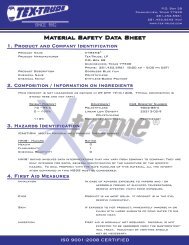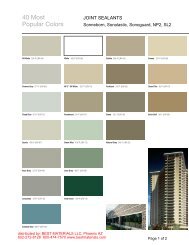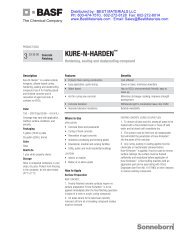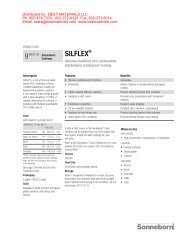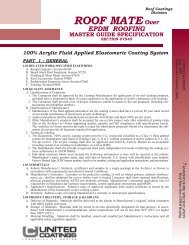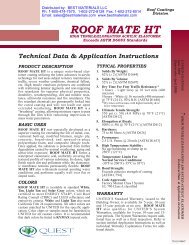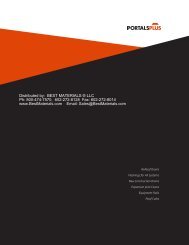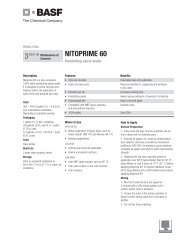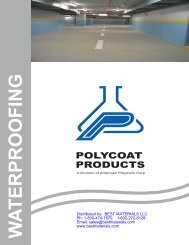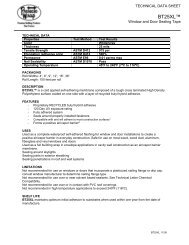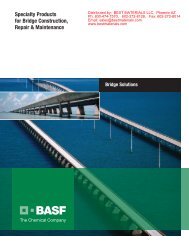Online Catalog Link - Best Materials
Online Catalog Link - Best Materials
Online Catalog Link - Best Materials
You also want an ePaper? Increase the reach of your titles
YUMPU automatically turns print PDFs into web optimized ePapers that Google loves.
Page A138/09EXPANSION OF METALS USED FOR ROOF DRAINAGEIncrease in 50 ft Length of Material Due to an Increase in Temperature of 100° FahrenheitNote: Material will decrease in length by the same distances due to a decrease in temperature of 100° Fahrenheit.Gutter Expansion:Galvanized Steel Copper Stainless Steel Aluminum ZincIncrease (in inches) 13/32" 5/8" 5/8" 25/32" 1 1/32"It is essential to provide expansion joints in all gutter installations to allow for movement due to temperature changes.In planning expansion joint locations, it must be recognized that an expansion joint acts as a dam in the gutter,therefore, the number and placement of downspouts will be influenced (see section on Proper Gutter and DownspoutSizing).No gutter length should exceed 50 ft without an expansion joint. Expansion joints should be installed to comply withthe SMACNA Architectural Sheet Metal Manual 5th Edition page 1.16 to 1.17 – Allowances For Gutter Expansion.There are two types of expansion joints commonly used in gutter installation, Lap Type and Butt Type. Both of thesetypes of expansion joints are easily fabricated on the jobsite using end caps and small amounts of sheet metal.Details for both Lap Type and Butt Type can be found in the SMACNA Architectural Sheet Metal Manual 5th Editionpages 1.18 to 1.21 – Lap Type Expansion Joint Figure 1-6 and Butt Type Expansion Joint Figure 1-7.BASIC SOLDERING TERMS AND TECHNIQUESThe successful application of soldering requires several elements that include properly tinned coppers, applicationand type of flux, properly blended solder, type of soldering tip, correctly heated coppers, properly prepared metalsurface free of oxidation and the skill of the person applying the solder.Common TermsTECHNICAL REFERENCE APPENDIXSolder – Any of various fusible alloys, usually made of tin and lead, used to join metallic parts.Soldering – joining or uniting of two or more pieces of metal by means of an alloy, usually tin and lead, having a lowermelting point than the pieces being joined.Soldering Coppers – an instrument for soldering, consisting of a bit or bolt of copper having a pointed or wedgeshapedend, and furnished with a handle. Soldering Coppers can have various shapes for different kinds of work.Tinning – covering the point of a soldering copper or other surface with solder.Flux – A substance applied to a surface to be joined by welding, soldering or brazing to facilitate the flowing of solderand prevent formation of oxides.Sal Ammoniac – another name for Ammonium Chloride (NH 4 Cl), is a white crystalline compound used as a soldering flux.Zinc Chloride – (ZnCl) A substance, also called cut or killed acid, which is unequalled as a flux when soldering galvanizedsteel, stainless steel and copper. It is colorless, odorless and corrosive; therefore it should be handled with care.Muriatic Acid – The commercial grade of Hydrochloric Acid (HCl), also called raw acid, which is used for making ZincChloride, used as a flux and for cleaning dirty parts of metal before they are soldered. It is colorless, has a sharppungent odor and is corrosive; therefore it should be handled with care.Rosin – The by-product of oil of turpentine that is a common, non-corrosive type of flux for soldering copper. Rosin isusually found in powder or paste form.Oxide – A compound that is formed on the surface of a metal due to a reaction with the oxygen in the air.(800) 523-8852 • Fax (215) 355-7738 • www.bergerbuildingproducts.com



